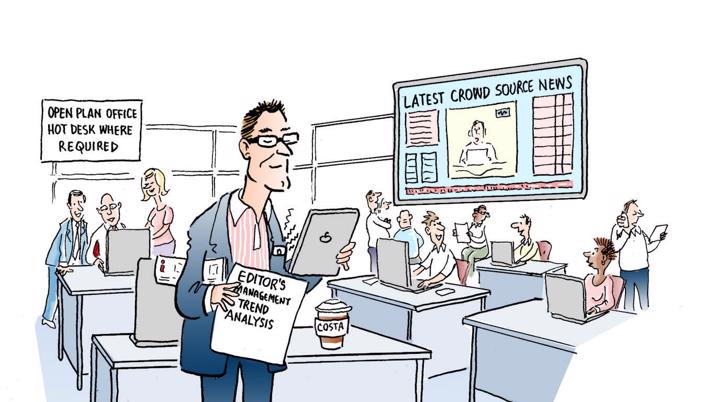
Apocryphal tales are often told in newsrooms across the nation about how editors used to act ‘back in the old days’. Not all of them are believable, some are unpleasant and a few that involve secretaries, the editor’s desk and closed office doors after hours are fairly unrepeatable.
But one of my favourites was recorded as fact in Copy! Boy! A ‘black’ from Brum, a mini-history of journalism during the 1950s in Birmingham, by former reporter Peter Deeley, (Parchment Press, 2006). Describing how the “ire of authority” could be aroused in old-fashioned, puffed-up editors, Deeley recalled: “Mr Jennings [former editor of the Birmingham Mail] was once roused in the night to be told the office was on fire. ‘Editors don’t put out fires,’ he replied, and went back to bed.”
It was this type of character from decades ago that I wanted to describe to delegates on a course entitled ‘The Modern Editor’ that I was delivering for Press Association Training last October. What were the best and the worst sides of the old-fashioned ‘king’ of the newsroom, and were any aspects worth retaining in today’s newsrooms?
To help visualise this discussion, I commissioned two images from Colin Whittock, the Birmingham Mail’s legendary cartoonist since the 1960s. No one, I thought, could create a better picture of the way editors have changed than Whittock, who has witnessed the comings and goings for more than 40 years, and is still going strong today.
It’s great to be accepted on the news floor, but going unnoticed doesn’t always keep staff on their toes.
‘Editors of old’
Whittock’s views are caricatures, of course, but just look at the way he’s captured how ‘editors of old’ appeared to their troops and readers half a century ago. Back then, the editor always seemed to be in his office with the door closed – and woe betide those who dared disturb him. You can see that his staff outside the door lived in fear of him, including his secretary-cum-gatekeeper, who desperately tried to keep the peace by making him pots of tea.
This ‘old’ editor felt he was upwardly-mobile, hence the pin-striped suits and bad ties that Whittock has dressed him in. He largely depended on phone and memo communications with staff, readers and anyone upstairs. He was at best grumpy, at worst ferocious to anyone with the temerity to complain to him.
His working day, folklore insists, was punctuated by alcohol (note the whisky decanter and his ruddy complexion), cash advances in preparation for non-receipted expenses (there’s piles of money to hand) and the terrifying spike – where any content that displeased him was mercilessly skewered.
And there was almost too much pride in the past (see the ‘old’ editor’s favourite front page framed on the wall behind him), indicating complacent satisfaction in stories or campaigns he’d once led, distracting staff from the need for fresh approaches to changing audiences.
Modern editors must become the best in-house lawyers and ethical guides for their desk heads to bounce issues off.
‘The modern editor’
How times have changed for ‘the modern editor’, depicted in Whittock’s second sketch. The newsroom is now open-plan, with the editor himself comfortable to be out there – and his staff seemingly relaxed about this.
Gone are the pin-stripes and tie, in are open-necked shirts, a ‘smart-but-casual’ style. The same can be said for most of the other staff pictured, displaying a more contemporary approach as they watch wall screens for the latest, digitally-inspired stories, openly discuss the news and compare their work.
Spot the spikes (there are none), note the hot-desking enabled by lap-tops, and see the editor’s chilled response to a ringing mobile (in his breast pocket), despite being busy analysing the latest trends and checking his title’s updates on his iPad.
Whittock has also cleverly included a posh coffee take-out – now the ubiquitous drink in today’s newsrooms – as opposed to sneaky alcoholic snifters at 11am and long, boozy lunches into the afternoon.
The best mix is somewhere in between – perhaps the type of editorial giant we saw in the 1980s and early 1990s.
The best of both worlds
So far, so good – as far as parodies of the past and present newsrooms are concerned. But surely there was something of value in the way editors of old used to ‘rule’ their newsrooms? And do the digitally-obsessed really deserve to inherit the earth, with their page templates, management reports and constant sobriety? The truth, of course, is that the very best of old and new characteristics are needed for the modern editor. Here’s the top ten…
- Leader. What makes brilliant editors and editorial managers? Great leadership. True leaders are visionaries – they know where the product is going, and they will do all within their powers to take it there. They have passion for the title; enthusiasm for the work. They have the ultimate desire to delight readers. Leading by example is the best way to start, of course. If the editor demands tweets and blogs, he – and increasingly she – had better be able to show they are active and successful in these areas themselves. Take Peter Barron, editor of the Northern Echo, as an example: watch how his tweets from @EchoPeterBarron attract more than 7,000 Twitter followers; and imagine how his newsroom is enthused at his constant blog-columns, ‘Dad At Large’ and ‘From The Editor’s Chair’.
- Motivator. Yes, it’s great to be accepted on the news floor, but going unnoticed doesn’t always keep staff on their toes. What’s wrong with the odd editor whose presence instils a certain sense of urgency and supreme effort from their team? The modern editor must motivate and inspire staff, other departments and their audience. They must listen to ideas, of course, but they should not be diverted from their main tasks. They must have courage, not only to stand up for their beliefs, but to stand up to their own people when required. Brilliant editors rarely please all of the people all of the time. Very occasionally, they need be prepared to fall out with someone within their own company.
- Transformer. Modern editors must always be prepared to rebalance the types of journalism required. Yes, they need to ensure that enough new media is created for increasingly-hungry digital appetites. But at the same time, they should demand that sufficient magical story-getting and writing skills are retained, to captivate traditional print audiences.
- Talent spotter. Probably, editors of old used too much ‘gut instinct’ to recruit, in days when staff numbers were flabby and several spare roles up their sleeves could be afforded. Those days are gone, and the modern editor needs, above all, to be a recruitment specialist, as it’s vital that no time or money is lost on job candidates that ‘might’ show promise. Every hour from every scarce employee counts in 2013, which means spending more time to make sure jobs go to the right people, with less time then wasted chasing the tails of poor staff.
- Lawyer. Old editors were often sticklers for media law, and never has this been more necessary than in today’s post-Leveson world. Modern editors must become the best in-house lawyers and ethical guides for their desk heads to bounce issues off. If editors know for sure what can and cannot be allowed – in print and online – then their staff will develop confidence in the way they approach stories. If editors waver, huge mistakes will be made.
- Money lender. What an old-fashioned term! But then the word ‘accountant’ is disliked on the news floor. Money is needed for good content, and money lenders need to be miserly. That means editors creating and keeping tight budgets – knowing them inside out to protect from overspends, but also to defend from too many management grab-backs. Modern editors should set and persistently monitor their own budgets, or else they’ll find that someone else will do it for them. And budgets micro-managed upstairs means editors lose the ability to plan content.
- Ambassador. Editors of old were too often found behind closed doors. It’s good that this has changed, and that open-plan offices are now the norm. But contact with the world doesn’t end in trendy, air-conditioned headquarters, too often based at out-of-town factory centres. Being a true ambassador means getting out and meeting readers, politicians and advertisers face-to-face, not just relying on social media. It might involve an occasional shandy…
- Communicator. In a similar way, modern editors must communicate clearly and frequently with staff. Just standing around in the newsroom doesn’t do it, however many gadgets are displayed. Talking to staff, cajoling style, tweaking intros, rewriting headlines, suggesting tweets, and standing on a chair to make major announcements – that’s communication, and it has to be relentless.
- Teacher. Continuously carrying out the above communications means the editor becomes one of the best teachers on the news floor. And, as we all know, great teachers command respect.
- Delegator. But no editor can do everything by themselves. By recruiting the right staff and then teaching them how they want things done with brilliant communications, the modern editor can delegate clear responsibilities to trusted lieutenants. This doesn’t mean editors putting their feet up back in the office, behind closed doors again. But it does mean they can get more things done, faster and at the same time.
The ‘editors of old’ from the 1950s and 1960s, as pictured by Whittock, died out with the dinosaurs. But his lampooning of ‘the modern editor’ warns newspapers against appointing those who are too bland, or too preoccupied with the latest management mantra. The best mix is somewhere in between – perhaps the type of editorial giant we saw in the 1980s and early 1990s. Outspoken, stirring, unafraid of taking on the big guns. A champion of their readers.
Which reminds me of a story about another editor. His name was Ian Dowell, editor of the Birmingham Mail from 1986 to 2000. In 1995, the then owner and chairman of Aston Villa FC, Sir Doug Ellis, decided to launch a free Sunday newspaper in a Birmingham suburb. Learning of his plans, Dowell launched a spoiler the week before. A short battle was fought, with Dowell insisting advertising was sold “cheap as chips” to beat his new opponent. Ellis’ paper ceased publication within six months, and Dowell then closed his weeks after.
The pair ended up on live local radio to debate the issue, and Dowell’s dulcet tones taunting the football legend were heard throughout the region: “If you want to play newspapers on my pitch, I’ll run off with your balls.”












